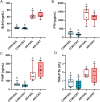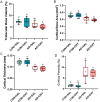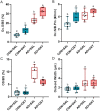Two Weeks of Continuous Opioid Treatment in an Adenine-Induced Mouse Model of Chronic Kidney Disease Exacerbates the Bone Inflammatory State and Increases Osteoclasts
- PMID: 38856730
- PMCID: PMC11246326
- DOI: 10.1007/s00223-024-01239-8
Two Weeks of Continuous Opioid Treatment in an Adenine-Induced Mouse Model of Chronic Kidney Disease Exacerbates the Bone Inflammatory State and Increases Osteoclasts
Abstract
Patients with chronic kidney disease (CKD) report high pain levels, but reduced renal clearance eliminates many analgesic options; therefore, 30-50% of CKD patients have chronic opioid prescriptions. Opioid use in CKD is associated with higher fracture rates. Opioids may directly alter bone turnover directly through effects on bone cells and indirectly via increasing inflammation. We hypothesized that continuous opioid exposure would exacerbate the high bone turnover state of CKD and be associated with elevated measures of inflammation. Male C57Bl/6J mice after 8 weeks of adenine-induced CKD (AD) and non-AD controls (CON) had 14-day osmotic pumps (0.25-µL/hr release) containing either saline or 50-mg/mL oxycodone (OXY) surgically implanted in the subscapular region. After 2 weeks, all AD mice had elevated blood urea nitrogen, parathyroid hormone, and serum markers of bone turnover compared to controls with no effect of OXY. Immunohistochemical staining of the distal femur showed increased numbers of osteocytes positive for the mu opioid and for toll-like receptor 4 (TLR4) due to OXY. Osteocyte protein expression of tumor necrosis factor-α (TNF-α) and RANKL were higher due to both AD and OXY so that AD + OXY mice had the highest values. Trabecular osteoclast-covered surfaces were also significantly higher due to both AD and OXY, resulting in AD + OXY mice having 4.5-fold higher osteoclast-covered surfaces than untreated CON. These data demonstrate that opioids are associated with a pro-inflammatory state in osteocytes which increases the pro-resorptive state of CKD.
Keywords: Chronic kidney disease; Inflammation; Opioids; Osteoclasts; Oxycodone.
© 2024. The Author(s).
Conflict of interest statement
CEM, GGG, LYT, BKA, and MRA declare that they have no conflict of interest.
Figures





Similar articles
-
Prolonged secondary hyperparathyroidism in adenine-induced CKD leads to skeletal changes consistent with skeletal hyporesponsiveness to PTH.PLoS One. 2025 May 23;20(5):e0324628. doi: 10.1371/journal.pone.0324628. eCollection 2025. PLoS One. 2025. PMID: 40408439 Free PMC article.
-
Oxycodone for cancer-related pain.Cochrane Database Syst Rev. 2022 Jun 9;6(6):CD003870. doi: 10.1002/14651858.CD003870.pub7. Cochrane Database Syst Rev. 2022. PMID: 35679121 Free PMC article.
-
Opioids for cancer pain - an overview of Cochrane reviews.Cochrane Database Syst Rev. 2017 Jul 6;7(7):CD012592. doi: 10.1002/14651858.CD012592.pub2. Cochrane Database Syst Rev. 2017. PMID: 28683172 Free PMC article.
-
The Black Book of Psychotropic Dosing and Monitoring.Psychopharmacol Bull. 2024 Jul 8;54(3):8-59. Psychopharmacol Bull. 2024. PMID: 38993656 Free PMC article. Review.
-
Hydromorphone for cancer pain.Cochrane Database Syst Rev. 2016 Oct 11;10(10):CD011108. doi: 10.1002/14651858.CD011108.pub2. Cochrane Database Syst Rev. 2016. Update in: Cochrane Database Syst Rev. 2021 Aug 5;8:CD011108. doi: 10.1002/14651858.CD011108.pub3. PMID: 27727452 Free PMC article. Updated.
References
MeSH terms
Substances
Grants and funding
LinkOut - more resources
Full Text Sources
Medical
Research Materials

